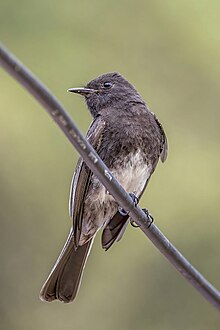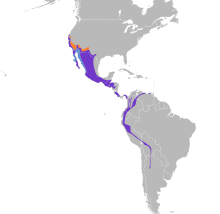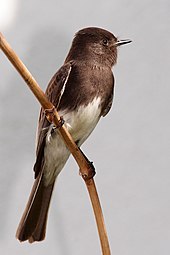| Black phoebe | |
|---|---|

| |
| Conservation status | |
 Least Concern (IUCN 3.1) | |
| Scientific classification | |
| Domain: | Eukaryota |
| Kingdom: | Animalia |
| Phylum: | Chordata |
| Class: | Aves |
| Order: | Passeriformes |
| Family: | Tyrannidae |
| Genus: | Sayornis |
| Species: | S. nigricans |
| Binomial name | |
| Sayornis nigricans (Swainson, 1827) | |

| |
The black phoebe (Sayornis nigricans) is a passerine bird in the tyrant-flycatcher family. It breeds from southwest Oregon and California south through Central and South America. It occurs year-round throughout most of its range and migrates less than the other birds in its genus, though its northern populations are partially migratory. Six subspecies are commonly recognized, although two are occasionally combined as a separate species, the white-winged phoebe.
The black phoebe has predominantly black plumage, with a white belly and undertail coverts. The sexes are identical in color, and juveniles have brown feather tips and brown wing-bars. Its song is a repeated tee-hee, tee ho. It lives in a variety of habitats but is always near water. It is mainly insectivorous and waits on a perch before sallying out and catching its prey in the air. It makes an open cup nest which is placed under a cliff or a bridge and cemented in its place with mud.
Description


The black phoebe is a medium-sized flycatcher, being 16 cm (6.3 in) in length and weighing 15 to 22 g (0.5 to 0.8 oz). It has predominantly black plumage, with white on its belly and undertail coverts. The white forms an inverted "V" in the lower breast. The sexes are identical and plumage does not vary seasonally. Juveniles have browner plumage, cinnamon-brown feather tips on their body, and brown wing-bars. The bird has brown irises and black legs, feet, and beak.
The phoebe can be recognized by a characteristic "tail-wagging" motion, in which the tail is lowered and the tail's feathers fanned out. It accomplishes almost all locomotion by flight, which is direct, with steady wing beats. Its song consists of two alternating phrases (tee-hee, tee-ho or sisee, sitsew). The song can be heard from both sexes, but is more commonly sung by males.
Systematics
The phoebes are a genus, Sayornis, of birds in the tyrant flycatcher family. The flycatchers are the largest family of birds on earth, with over 400 known species. The genus name was given by George Robert Gray of the British Museum, and is named after Thomas Say, an American naturalist. The species name, nigricans, is Latin for "blackish", and was given by William John Swainson in 1827.
The black phoebe has six subspecies, but these can be divided into two groups which are sometimes considered to be separate species: the nigricans group (black phoebe) and the latirostris group (white-winged phoebe). The first group contains four subspecies, the second group two.
| Subspecies | Range | Appearance |
|---|---|---|
| S. n. semiatra | Southwest United States to western Mexico, including Baja California. | Most white on belly of all subspecies; pale edging on wings and tail. |
| S. n. nigricans | Nominate subspecies; northeast, central, and southern Mexico. | Less white on belly than semiatra; white forms an inverted "U" instead of "V". |
| S. n. aquatica | Chiapas, Mexico, through Nicaragua. | White only on midbelly and vent. |
| S. n. amnicola | Costa Rica and Chiriquí Province, Panama. | Darkest subspecies; less white on abdomen. |
| S. n. angustirostris | Eastern Panama south through central Bolivia. Sometimes considered separate species with S. n. latirostris. | Extensive white edging on primary and tertial rectrices. |
| S. n. latirostris | Bolivia and northwest Argentina. Sometimes considered separate species with S. n. angustirostris. | Extensive white edging on rectrices and underwing lining. |
Distribution and habitat
The black phoebe breeds in the west and southwest United States, Mexico and Central America, and parts of South America. In Oregon it is found in river valleys on the Pacific coast, and in California on the western side of Coast Ranges. It breeds throughout the Colorado River valley and occasionally is found to the north in southern Nevada and southwestern Utah, as well as Arizona and central New Mexico. The black phoebe's breeding range in the United States extends as far southeast as the Lower Rio Grande Valley. In Central America it breeds on Baja California, except for the central part of the peninsula, and on interior mainland Mexico southwest to Panama, excluding El Salvador. In South America it is found in the coastal mountains of Venezuela, through Colombia, Ecuador, and Peru, to western Bolivia and northwestern Argentina.
It lives year-round in most of its range and is more sedentary (non-migratory) than either of the other phoebes in its genus (Eastern or Say's), although northern populations may be partially migratory. It is always found near water and is often found at coastal cliffs, river/lake banks, or even park fountains. Habitats must also include a supply of mud for nest building, and the birds' specialized nesting requirements probably cause their somewhat irregular range.
References
- ^ BirdLife International (2016). "Sayornis nigricans". IUCN Red List of Threatened Species. 2016: e.T22699892A93754368. doi:10.2305/IUCN.UK.2016-3.RLTS.T22699892A93754368.en. Retrieved 11 November 2021.
- "Black Phoebe, Life History". All About Birds. Cornell Lab of Ornithology. 1997. Retrieved 5 November 2010.
- Wolf, Blair O. (1997). "Black Phoebe — Distinguishing Characteristics". Birds of North America. Cornell Lab of Ornithology. Retrieved 5 November 2010.
- Terres, John K. (1980). "Phoebe, black". The Audubon Society Encyclopedia of North American Birds. New York: Alfred A. Knopf. p. 392. ISBN 0-517-03288-0.
- Wolf, Blair O. (1997). "Black Phoebe —Behavior". Birds of North America. Cornell Lab of Ornithology. Retrieved 5 November 2010.
- Sibley, David Allen (2000). The Sibley Guide to Birds. New York: Alfred A. Knopf. p. 330. ISBN 0-679-45122-6.
- Smith, W. John (1970). "Song-Like Displays in Sayornis Species". Behaviour. 37 (1/2). Brill Publishers: 64–84. doi:10.1163/156853970X00240. JSTOR 4533346.
- Peterson, Roger Tory; Virginia Marie Peterson (2002). A field guide to the birds of eastern and central North America. New York: Houghton Mifflin Harcourt. p. 199. ISBN 0-405-10737-4.
- Weiss, Harry B.; Grace M. Ziegler (1978). Thomas Say, early American naturalist. New York: Arno Press. p. 267. ISBN 0-395-74047-9. Retrieved 5 November 2010.
- Smith, William (1855). A Latin-English Dictionary. London: John Muray. p. 723. ISBN 0-7195-1307-3. Retrieved 5 November 2010.
- * Fjeldså, Jon; Krabbe, Niels (1990). Birds of the High Andes: A Manual to the Birds of the Temperate Zone of the Andes and Patagonia, South America. Svendborg, Denmark: Apollo Books. p. 491. ISBN 87-88757-16-1.
- ^ Wolf, Blair O. (1997). "Black Phoebe — Systematics". Birds of North America. Cornell Lab of Ornithology. Retrieved 5 November 2010.
- Ortiz, Samuel G.; Gabler, Christopher A.; Brush, Timothy (2019). "Continued Eastward Range Expansion of Black Phoebes (sayornis Nigricans) in Southernmost Texas". The Southwestern Naturalist. 64 (3/4): 231–232. ISSN 0038-4909. JSTOR 27100236.
- Grinnel, Joseph; Storer, Tracy Irwin (1924). Animal life in the Yosemite. Berkeley, CA: University of California Press. pp. 362–363. ASIN B00467P3XC.
Further reading
- Skutch, Alexander F. (1960). "Black phoebe" (PDF). Life Histories of Central American Birds II. Pacific Coast Avifauna, Number 34. Berkeley, California: Cooper Ornithological Society. pp. 365–373.
External links
- Black phoebe - Sayornis nigricans - USGS Patuxent Bird Identification InfoCenter
- Species Account – Cornell Lab of Ornithology
- "Black phoebe media". Internet Bird Collection.
- Black phoebe photo gallery at VIREO (Drexel University)
- Interactive range map of Sayornis nigricans at IUCN Red List maps
| Taxon identifiers | |
|---|---|
| Sayornis nigricans |
|
| Tyrannula nigricans | |
- IUCN Red List least concern species
- Sayornis
- Native birds of the Southwestern United States
- Native birds of the West Coast of the United States
- Fauna of the California chaparral and woodlands
- Birds of the Rio Grande valleys
- Fauna of the Lower Colorado River Valley
- Birds of Central America
- Birds of the Northern Andes
- Least concern biota of North America
- Least concern biota of the United States
- Birds described in 1827
- Taxa named by William John Swainson